
Native American agriculture, 1200 AD
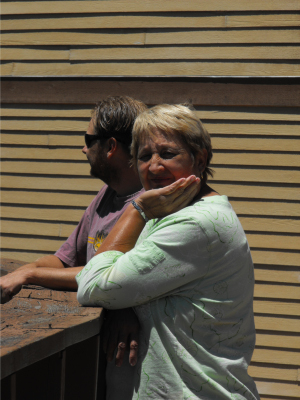 This
weekend, I tricked Mark and his mom into taking me to Sunwatch Indian
Village in Dayton. My companions win the patience award for not
even looking bored while I took notes for three hours on how Native
Americans fed themselves 800 years ago. Okay, maybe they do look
a little bored....
This
weekend, I tricked Mark and his mom into taking me to Sunwatch Indian
Village in Dayton. My companions win the patience award for not
even looking bored while I took notes for three hours on how Native
Americans fed themselves 800 years ago. Okay, maybe they do look
a little bored....
I was intrigued by this
particular window into the past because corn had just become the
mainstay of the Native American diet, making up over half of the
villagers' diets. Meat (76% of which was venison) made up another
40% of their diets, so I wasn't surprised that the Sunwatch villagers
were actually less healthy than their recent ancestors, with over half
of their children dying before the age of six. We all know that a
diet of corn and meat with very few fruits and vegetables isn't going
to promote good health.
The villagers stored
their corn for the winter in large, grass-lined storage pits.
Each family of six to eight people had their own pit, which would hold
500 or more pounds of corn. I loved the museum's reconstruction
of a typical storage pit while in use:
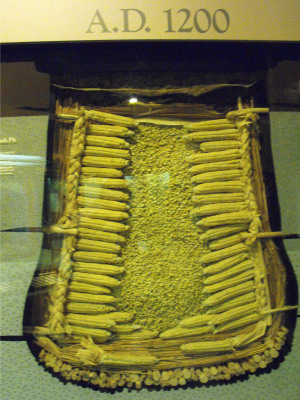
...and then, once
emptied of corn, how it might have looked when filled with the family's
garbage...
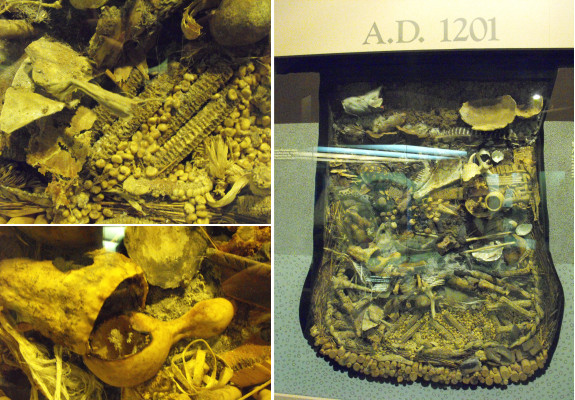
...and, finally, what
the pit looked like when archaeologists carefully picked through it 800
years later:
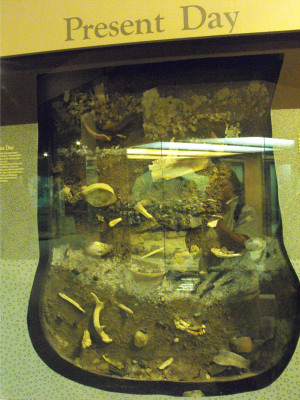
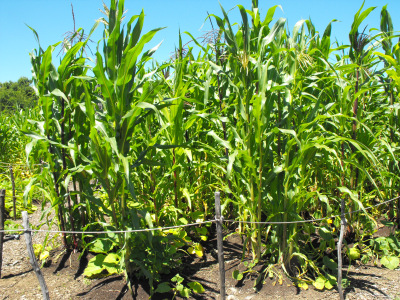 The
reconstructed village also included a typical three
sisters garden,
which I've pictured here. Unfortunately, there was much less
interpretation about the garden than about the buildings, so I came
away with more questions than answers. Most importantly, I ended
up curious about how the Native Americans combatted the squash vine
borers, which my
trained eye noticed were already hard at work wiping out the pumpkins
in Sunwatch's garden. Does anyone know?
The
reconstructed village also included a typical three
sisters garden,
which I've pictured here. Unfortunately, there was much less
interpretation about the garden than about the buildings, so I came
away with more questions than answers. Most importantly, I ended
up curious about how the Native Americans combatted the squash vine
borers, which my
trained eye noticed were already hard at work wiping out the pumpkins
in Sunwatch's garden. Does anyone know?
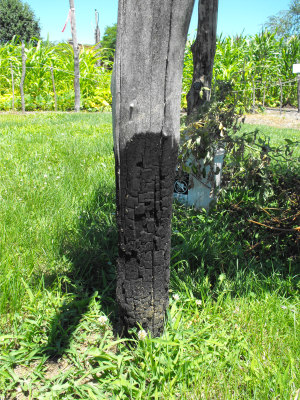 I
posted some images of the lodges in my review
of Sunwatch Village
over on our Clinch Trails website (which I've decided
to reenvision as our travel website), but what caught my eye in the
architectural arena was the way the Native Americans burned the bases
of their posts to protect the wood from insects and rot. I would
have thought that charring the base of a post would make it less
structurally sound, but presumably they knew what they were doing.
I
posted some images of the lodges in my review
of Sunwatch Village
over on our Clinch Trails website (which I've decided
to reenvision as our travel website), but what caught my eye in the
architectural arena was the way the Native Americans burned the bases
of their posts to protect the wood from insects and rot. I would
have thought that charring the base of a post would make it less
structurally sound, but presumably they knew what they were doing.
On the other hand, the
buildings weren't meant to last forever. Like my method of intentionally
underbuilding, the
Sunwatch villagers were used to moving on after a couple of decades
when firewood and game in the immediate vicinity had been
exhausted. As with slash
and burn agriculture,
the sustainability of using up all of an area's resources and then
travelling to a new region is questionable, but the method might make
sense if populations are low enough that the land is given a century to
recover after each episode.

Finally, doesn't this
watch platform look perfect? I've long wanted to have one of
these in the middle of the garden with a ramp up to the platform so
Lucy could nap there and watch over our entire domain. Who knows
--- the Sunwatch villagers might have even let their dogs stand watch
there too!
Want more in-depth information? Browse through our books.
Or explore more posts by date or by subject.
About us: Anna Hess and Mark Hamilton spent over a decade living self-sufficiently in the mountains of Virginia before moving north to start over from scratch in the foothills of Ohio. They've experimented with permaculture, no-till gardening, trailersteading, home-based microbusinesses and much more, writing about their adventures in both blogs and books.
Want to be notified when new comments are posted on this page? Click on the RSS button after you add a comment to subscribe to the comment feed, or simply check the box beside "email replies to me" while writing your comment.

Interesting storage method for the corn! But what about groundwater and burrowing animals?
With regard to the poles, it could be a technique evolved from fire hardening of spear points. The poles of the platform look overdimensioned. I'd guess that one or two of those poles would be enough to support the weight of one person. So burning the top layer of the poles is not that big of a deal.
Last year was a mistake, but this year I did it to repeat the results.
I tilled up a spot, planted my seed and then neglected it. Surprisingly after all my squash in the garden died, I looked and the vines had squash.
Although the plants growth is stunted (plants are smaller and later), they look much healthier and produce much more. Last year I got a grand total of 2 squash before all of my vines turned yellow and died. But the others produced well. I am having the same results this year. Although my squash in the garden produced better this year, they are now tilled under and the overgrown plants are still producing?
Next year I think I will only plant one hill in the garden for some early squash and plant the remainder in the pasture.
Groundwater was my first thought too! I can only guess that they have very sandy soil and good drainage at Sunwatch. The village is near a river, which often means sandy soil and potentially good drainage. I read in a book that the Native Americans in the prairie states all used pits like this to store corn, but that those in the south used aboveground cribs. I sure wouldn't try these pits in our swampy soil!
Thanks for the thoughts on fire hardening. That would make a lot of sense!
What kind of squash were you growing? We mostly have trouble with our summer squash --- butternuts plug right along, and our cucumbers and melons get wiped out by other things.
Our first year here, though, we had a great summer squash harvest with no borer damage. I suspect it just took a year for the borers to find us. Perhaps if your pasture is far enough from your garden, that could be what's going on with you too? I don't know how far apart you'd have to plant each year's patch to take advantage of that effect, but it might be worth a shot.
On the other hand, for some reason, the vine borers seem to be mostly leaving us alone this year?!!! Our summer squash have slowed down a bit, but I still froze a quart and a half today after being gone a few days. Since my next set of squash is about to start blooming, I suspect succession planting might do the trick!
You might read Notes on a Lost Flute by Kerry Hardy to get your head around pre-contact / early contact agriculture. It's about the Wabanaki of Maine but the descriptions of how they manipulated the land will show you that "slash & burn" isn't necessarily a bad thing if done the way they did it. It's also a good book for the pretty illustrations and the format.... it's the sort of thing you can read in those 5 minute intervals that summer's work grants us for such pleasures.
http://www.amazon.com/Notes-Lost-Flute-Field-Wabanaki/dp/0892727799
Another book that I'm working through right now is Buffalo Bird Woman's Garden. (You'll need 10 minute intervals for that one.) I'm gleaning a lot of useful information even though it's prairie agriculture.
The cultures in central america certainly left more in the way of monuments built in stone.
But I'm kind of ambivalent about those. On the one hand they are often remarkable technical achievements, but on the other hand many are temples for nonexisting gods and weird religions (pleonasms, but I digress), and as such a giant waste of time and resources. If some of these cultures had focused their efforts on managing their resources (I seem to recall that several of them failed because of drought) they might have lasted longer.
As to why a lot of north american tribes didn't leave a lot of monuments, you'd have to ask a specialist. It's an interesting question, though. It could be something as mundane as available building materials; wood is easier to work than stone. Or for some of the tribes it could be because they were essentially nomads. They certainly didn't seem to spend their lives building temples and monuments for whatever they worshipped. Very sensible in my eyes.
Personally I find things like the corn storage and remains of houses and tools much more interesting, because it tells is much more about how these people lived.
I agree with you that learning about the way earlier people lived and planted is fascinating! On the other hand, I've started getting into the monuments they left behind as well. It's amazing to be on a mound or pyramid built by hand hundreds of years ago.
About them being temples for nonexisting gods and weird religions --- I think all gods are nonexisting and all religions weird, so I figure these are no weirder than any others. I still find some cathedrals fascinating and beautiful. (Though, I totally agree, a waste of resources!)
I still find some cathedrals fascinating and beautiful. (Though, I totally agree, a waste of resources!)
And I've been noticing recently that there are a lot of native North American monuments, although they're nearly all built of earth, not rock. I really thought that early Native Americans were mainly just nomadic, but I got engrossed in reading Wikipedia this weekend and learned that during the Mississippian cultural period, there were actually large settlements based around growing corn. Lots of interesting artifacts from that time, and mounds! (Yes, I'm now obsessed.)
Anna, I'll ask around about a book on native farming. It'll take me a while, but it's something I'm wanting to read more on too.
One reason we don't see eastern N. American monuments is because nearly all the mounds of the Mississippian period were razed for fill dirt or religious reasons by white folks in the last 150 years or so. Another reason is because we're looking for fancy buildings when an important "monument" may be a precariously balanced rock. Lots of stuff out west... the Anasazi were building structures relative to mind bogglingly complex astronomical alignments, into cliff faces, in canyon networks, with straight line geometry between them, purely for religious use and abandoned it all by 1200. (Because of drought & raids.)
You might consider attending Wisdom of the Elders in KY to meet some living native women who can point you in a good direction. The folks there are exceptionally open to non-natives who want to learn the old(er) ways. So far there are only dates on the website but a call will likely get you all the info you desire. http://www.mantlerock.org/
The Wisdom of Elders group sounds wonderful, but they're in the wrong part of the state! With Kentucky just over the next hill (well, mountain), it's a shame that part of Kentucky is 7 hours away.
Any books you can recommend would be much appreciated!
My point exactly! I guess I was being too subtle.
Now that's not something I get a lot.
Quite on the contrary, it does. By giving special consideration to religious beliefs they acquire respect that they not deserve.